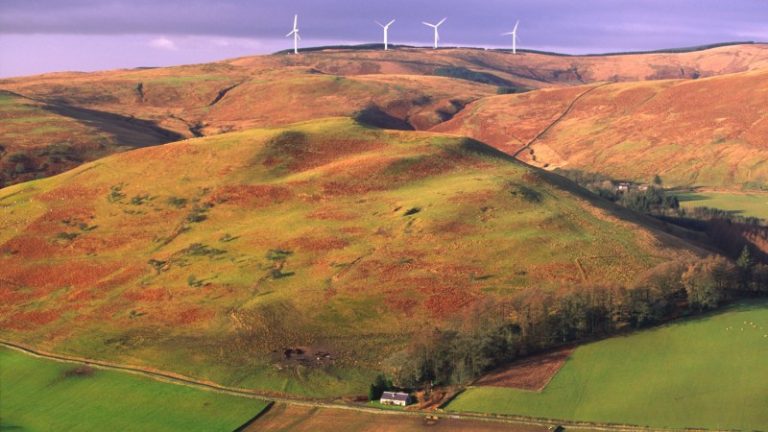National Grid embarks on power trip to future-proof supply
If anyone was in any doubt about the mountainous task facing National Grid, it was made all too clear today. According to John Pettigrew, the chief executive of National Grid, Britain is “at the foothills of the energy transition” and the company is facing the challenge of future-proofing the nation’s power network. Hence its vast £60 billion spending plan.
At the heart of the issue is renewable energy. The design and capacity of the nation’s electricity grid has failed to keep pace with the rapid expansion of renewables, notably wind power that is heavily concentrated in Scotland and on the east coast of England.
The government has said it wants to increase offshore wind capacity to 50 gigawatts by 2030, from about 14GW at present, in an attempt to decarbonise the electricity system by 2035. One gigawatt equates to roughly the power required to power a million homes.
Renewable energy accounted for 41 per cent of Britain’s electricity generation last year, according to figures from the National Grid’s Electricity System Operator, up from about 16 per cent a decade ago. On the other side of the ledger, electricity demand is expected to increase by 50 per cent by 2035 as people replace petrol and diesel cars with electric vehicles and switch their household gas boilers for electric heat pumps.
“All of those things have contributed towards making the system much more complicated and also mean that, after a decade of underinvestment, we’re going to see an increase in electric demand and an increase in demand for less consistent generation, renewables primarily,” Charles Wood, the deputy director for policy at Energy UK, said.

The sharp rise in renewables and energy storage projects has led to lengthy delays in getting projects connected to the grid, which operates on a first-come, first-served basis. To speed up the process, Ofgem and the government are seeking to overhaul the approvals process. That includes project developers now needing to meet new delivery milestones to show that their project is progressing; if they don’t, the risk being kicked out of the queue.
And it’s a long queue. The list of energy projects awaiting connection has reached more than 700GW, according to National Grid statistics, of which 97GW are battery storage projects. To put this into context, Britain’s entire operational wind capacity, both onshore and offshore, stands at nearly 30GW.
“There are obvious issues there in terms of investment and certainty for the sector,” Wood said, which includes the risk that generation or storage developers take their projects outside the UK, where they may be able to get a faster grid connection.
Without the capacity of the electricity grid to cope with the level of renewables on the system, there is the chance that the Electricity System Operator, which manages supply and demand on the network, will have to increase the amount it pays renewable generators to switch off to prevent the system being overloaded.
Constraints on grid capacity cost bill-payers a total of £970 million last year, paying gas plants to switch on when renewable generation was insufficient and asking wind farms to turn off to prevent the network becoming overloaded.

About £670 million of this was attributed to the boundary line between Scotland and England, according to research by Field, a British start-up focused on battery storage for renewable technologies. That could rise more than threefold to £2.2 billion by the end of the decade, its analysis suggests.
ScottishPower and National Grid, which own the transmission lines along the boundary between Scotland and England, have set out plans to spend billions of pounds on upgrading the transmission and local distribution lines needed to carry power from Scotland, where generation is highest, to the south of England, the area of greatest demand.
Moreover, the challenge is not simply a capacity issue. The evolution of the energy mix from coal to gas to an increasing level of renewable energy has created a design problem.

“The UK is a system where generation was close to the coalmines in the north and with power flowing north to south,” Pettigrew said. “With more offshore wind coming on board, more infrastructure’s going to have to run from east to west.”
How easily National Grid is able to put its cash to work will depend in part on policy reforms. In making a radical package of recommendations aimed at speeding up the expansion of the hundreds of miles of high-voltage cables needed to connect new wind farms, Nick Winser, the government’s independent adviser, found that developing and building new power lines could take up to 14 years. That timescale needed to be halved to achieve the government’s decarbonisation goals, he said in his report. The government has said that it wants to reduce the construction time to five years.
“We have said to the government that planning reform is going to be needed if you want to build infrastructure more quickly,” Pettigrew said, adding that securing the supply chain, both in terms of parts and workforce, was another potential challenge. It also would be important to make clear the community benefit, he said, since a lot of the network infrastructure was going to be hosted in areas where it has not previously been in the past.
A move that does not come cheap
Britain’s biggest rights issues have largely come during times of crisis, but FTSE 100 companies also have offered a discount on shares to fund acquisitions and restructurings.
Such moves do not come cheap. National Grid said in the prospectus for its rights issue that the cost of fees for advisers and other expenses would be £165 million. Barclays and JP Morgan are underwriting the fundraising, with Robey Warshaw, the boutique investment bank where George Osborne, the former chancellor, is a partner, also advising on the deal.
Some of the most significant rights issues came in the financial crisis, when Royal Bank of Scotland, HBOS, Lloyds Banking Group and HSBC sought emergency funding from investors. Not all were successful, as HBOS achieved a take-up of less than 10 per cent for its £4 billion cash-call in 2008. Lloyds called on investors for £13.5 billion of new capital at a discount of 60 per cent in 2009 after its merger with HBOS.
RBS’s crisis-era fundraising spawned a legal case from thousands of shareholders who claimed that they had been misled into backing the £12 billion deal shortly before the bank’s collapse. They claimed the prospectus had contained untrue or misleading statements about the state of the bank’s finances and they wanted Fred Goodwin, its former chief executive, to give evidence in court. RBS denied the allegations and Goodwin avoided a public appearance as the lender agreed a settlement with the investors.
Imperial Tobacco and Rio Tinto raised billions through rights issues in 2008-09. Imperial Tobacco launched a £4.9 billion discounted share sale to fund its acquisition of Altadis, the Spanish cigarette maker, in 2008, and Rio Tinto sought to reduce its debt with a $15.2 billion issuance in 2009.
Standard Chartered joined its peers in the finance industry issuing rights issues years after the financial crisis when Bill Winters, its chief executive, sought £3.3 billion from investors to fund a plan to cut 15,000 jobs in 2015.
More recently, British companies raised billions through discounted share sales during the pandemic.






